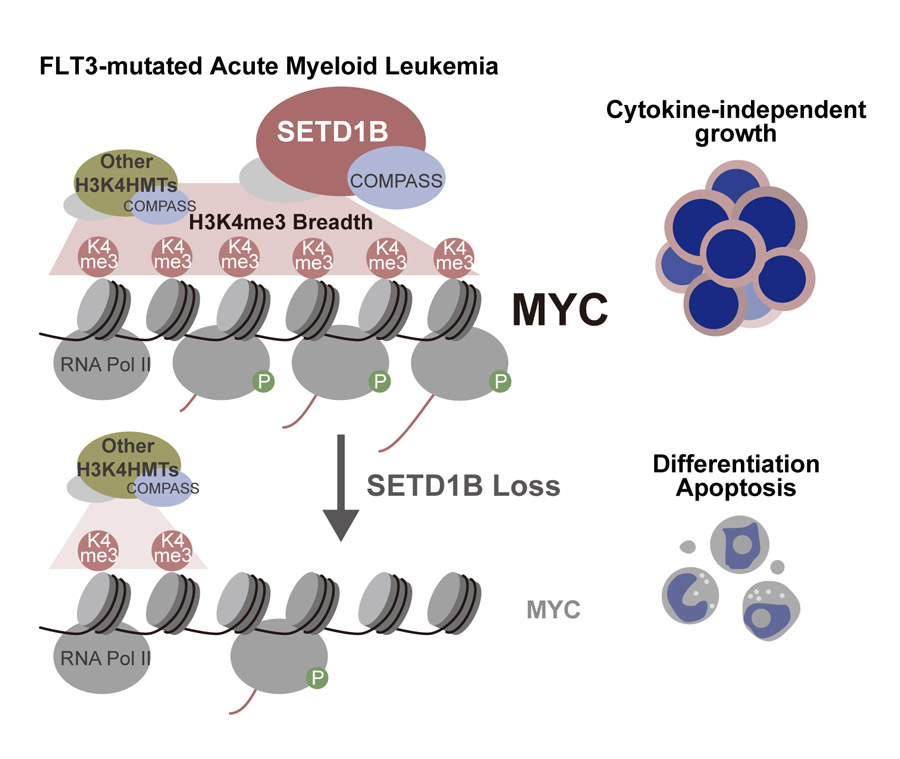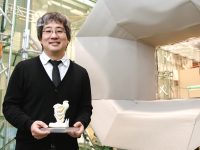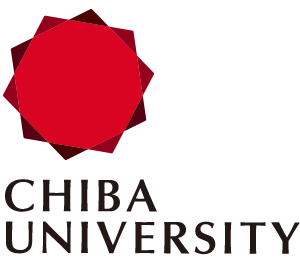Researchers find a modifier of histone protein and its regulator that slows cancer growth in high-risk leukemia
Aggressive forms of acute myeloid leukemia (AML) remain challenging to treat, especially in patients with FLT3-ITD mutations. Researchers from Japan have identified SETD1B as a key epigenetic regulator that promotes leukemia cell growth by promoting MYC activation through H3K4me3 modification. Using laboratory models, they demonstrated that disrupting SETD1B significantly slows cancer cell proliferation. These findings offer promising new avenues for developing therapies against treatment-resistant AML.

Image title: Study finds SETD1B drives aggressive growth in FLT3-mutated acute myeloid leukemia (AML)
Image caption: This model illustrates how SETD1B promotes the expansion of H3K4me3 epigenetic marks and upregulates MYC expression, driving cytokine-independent cell growth in FLT3-mutated AML.
Image credit: Dr. Takayuki Hoshii from Chiba University, Japan
Image link: https://www.nature.com/articles/s41375-025-02638-y
Image license: CC BY 4.0
Usage Restrictions: Credit must be given to the creator.
Acute myeloid leukemia (AML) is an aggressive cancer affecting the blood and bone marrow that progresses rapidly, making immediate treatment essential. While chemotherapy and targeted drugs have improved outcomes for some patients, many forms of AML remain resistant to treatment, and relapses are common.
A new study sheds light on why certain types of AML are so challenging to treat and how outcomes for patients might be improved. Researchers from Japan, including scientists from Chiba University, have discovered that an epigenetic enzyme called SETD1B plays a critical role in supporting the growth of a particularly aggressive form of AML—especially in patients with the Fms-like tyrosine kinase-3 internal tandem duplication (FLT3-ITD) mutation, a genetic change associated with poor prognosis and high relapse rates. By targeting SETD1B, the researchers believe, it may be possible to develop more effective treatments that prevent leukemia cells from multiplying.
The study was led by Associate Professor Takayuki Hoshii and included Dr. Shintaro Izumi and Professor Atsushi Kaneda from the Graduate School of Medicine, Chiba University, Japan. The findings were published online in the journal Leukemia on May 8, 2025.
“Patients with AML, especially with the FLT3-ITD mutation, often respond poorly to current therapies. Our findings are that the epigenetic regulator SETD1B protein supports aggressive cell proliferation in AML by promoting oncogenic MYC expression,” says Dr. Hoshii.
Previous research has shown that FLT3-ITD mutations are detected in patients with mixed-lineage leukemia-rearranged (MLL-r) AML, a subtype of leukemia characterized by genetic abnormalities. MLL-r AML cells exhibit high levels of histone H3 lysine 4 trimethylation (H3K4me3), an epigenetic modification that affects which genes are turned on or off without changing the DNA sequence. Though the link between MLL-r AML and H3K4me3 has been established, the association between FLT3-ITD and H3K4me3 remains unclear.
Using advanced genetic screening tools, the team identified Setd1b as the gene responsible for producing a protein that adds methyl groups to histone H3 at lysine 4, resulting in the H3K4me3 epigenetic modification, and upregulation of Myc genes, which plays a critical role in regulating cell growth, division, and metabolism and can contribute to cancer development if altered.
To understand the role of SETD1B, the researchers performed CRISPR screening and then genetically engineered leukemia cells with altered versions of SETD1B, specifically deleting its catalytic domain, which is the active part of the protein responsible for the epigenetic modification of the DNA. They then used RNA sequencing and chromatin mapping to identify which genes and pathways were most affected.
Their experiments revealed that removing SETD1B’s catalytic domain significantly slowed cancer growth, particularly in leukemia cells with FLT3-ITD or NrasG12D mutations. It also caused a drop in the activity of genes in the MYC pathway. This suggests that without the epigenetic function of SETD1B, MYC cannot remain fully active, weakening the ability of the cancer cells to grow and divide.
“The breadth of H3K4me3 is crucial for transcriptional consistency, and MYC expression appears highly dependent on both the quality and quantity of transcriptional elongation,” says Dr. Hoshii. “Understanding SETD1B’s role in maintaining this epigenetic mark is critical for developing biomarkers and therapies for leukemia subtypes and other MYC-driven cancers.”
Interestingly, when the researchers reintroduced the Myc gene back into leukemia cells lacking SETD1B, the cancer cells began to grow again, but only partially, suggesting that SETD1B plays a broader role in MYC’s cancer-promoting activity.
This discovery paves the way for new treatment strategies. By targeting SETD1B or its epigenetic functions, scientists may be able to develop therapies that are especially effective for patients with FLT3-ITD mutations. As a possible next step, the researchers point to Chaetocin, an existing compound known to inhibit enzymes related to SETD1B. This could serve as a foundation for developing more selective SETD1B-targeted drugs. Measuring SETD1B activity in patients might also help doctors predict who would benefit most from these therapies.
As the search for better treatments continues, this study reveals how targeting the cancer’s epigenetic machinery could provide a new strategy to treat the disease, giving hope to patients with aggressive forms of AML.
About Associate Professor Takayuki Hoshii
Dr. Takayuki Hoshii is an Associate Professor at the Graduate School of Medicine, Chiba University. His research focuses on how epigenetic mechanisms drive childhood leukemia, particularly through abnormal transcriptional regulation. By investigating factors like chromatin modification and MYC expression, Dr. Hoshii aims to identify novel therapeutic targets. He recently revealed how key proteins function during the “set” phase of gene transcription, contributing to cancer progression. He is a member of several academic societies, including the Japanese Society of Hematology and the Japanese Society for Epigenetics, and approaches research with the philosophy: “Keep making hypotheses, keep discarding hypotheses, and value the results.”
Funding:
This work was supported by grants from JSPS KAKENHI (JP19H03690, JP19K22399, JP22H03099, and JP22H04684), Japan Agency for Medical Research and Development (AMED) (23ama221118h0002), Kobayashi Foundation for Cancer Research, and Takeda Science Foundation. This work was also supported by IAAR Research Support Program from Chiba University.
Reference:
Title of original paper: Regulation of H3K4me3 breadth and MYC expression by the SETD1B catalytic domain in MLL-rearranged leukemia
Authors: Shintaro Izumi1,2, Ko Ohtani1,2, Makoto Matsumoto1, Seito Shibata1, Bahityar Rahmutulla1, Masaki Fukuyo1, Mitsutaka Nishimoto3, Hideo Miyagawa4, Emiko Sakaida2, Koutaro Yokote2, Issay Kitabayashi5, Kimi Araki6,7, Atsushi Kaneda1,8, and Takayuki Hoshii1
Affiliations:
- Department of Molecular Oncology, Graduate School of Medicine, Chiba University, Japan
- Department of Endocrinology, Hematology and Gerontology, Graduate School of Medicine, Chiba University, Japan
- Department of Hematology, Osaka Metropolitan University Graduate School of Medicine, Japan
- Preventive Medicine and Environmental Health, Graduate School of Medicine, Osaka Metropolitan University, Japan
- Oncology Innovation Center /Center for Translational Research, Fujita Health University, Japan
- Division of Developmental Genetics, Institute of Resource Development and Analysis, Kumamoto University, Japan
- Center for Metabolic Regulation of Healthy Aging, Kumamoto University, Japan
- Health and Disease Omics Center, Chiba University, Japan
Journal: Leukemia
DOI: 10.1038/s41375-025-02638-y
Contact: Takayuki Hoshii
Graduate School of Medicine, Chiba University
Email: hoshiit@chiba-u.jp
Academic Research & Innovation Management Organization (IMO), Chiba University
Address: 1-33 Yayoi, Inage, Chiba 263-8522 JAPAN
Email: cn-info@chiba-u.jp
Recommend
-

An insect and machine enthusiast delves into the flight mechanism of living organisms: From the mosquito flapping to the high-performance drones
2024.03.12
-

Cracking Error with Math: Error Correction in Classical and Quantum Computers
2024.09.02
-

Inside the Brain: How fMRI Sheds Light on Mental Disorders
2025.10.10


